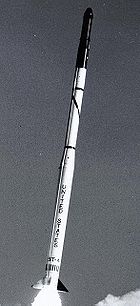
Explorer 9
Encyclopedia
Explorer 9, known as S-56A before launch, was an American
satellite which was launched in 1961 to study the density and composition of the upper thermosphere
and lower exosphere
. It was a reflight of the failed S-56 mission, and consisted of a 7 kilograms (15.4 lb), 3.7 metres (12.1 ft) balloon which was deployed into a medium Earth orbit
. The mission was conducted by NASA
's Langley Research Center
.
 Explorer 9 was launched from Launch Area 3
Explorer 9 was launched from Launch Area 3
at the Wallops Flight Center
, atop a Scout X-1
rocket with the serial number ST-4. It was the first spacecraft launched from Wallops Island to achieve orbit, with one previous attempt having failed. The launch occurred at 13:05:00 UTC on 16 February 1961, and resulted in Explorer 9 being deployed into a orbit with an apogee
of 2581 kilometres (1,603.8 mi), a perigee
of 635 kilometres (394.6 mi), 38.8 degrees of inclination
and a period of 118.4 minutes. It was assigned the Harvard designation 1961 Delta 1.
The second of six identical air density research satellites to be launched, Explorer 9 was the first to successfully reach orbit. It was still operational when the next satellite, Explorer 19, was launched, allowing simultaneous readings to be taken and compared. It decayed from orbit on 9 April 1964.
United States
The United States of America is a federal constitutional republic comprising fifty states and a federal district...
satellite which was launched in 1961 to study the density and composition of the upper thermosphere
Thermosphere
The thermosphere is the biggest of all the layers of the Earth's atmosphere directly above the mesosphere and directly below the exosphere. Within this layer, ultraviolet radiation causes ionization. The International Space Station has a stable orbit within the middle of the thermosphere, between...
and lower exosphere
Exosphere
The exosphere is the uppermost layer of Earth's atmosphere. In the exosphere, an upward travelling molecule moving fast enough to attain escape velocity can escape to space with a low chance of collisions; if it is moving below escape velocity it will be prevented from escaping from the celestial...
. It was a reflight of the failed S-56 mission, and consisted of a 7 kilograms (15.4 lb), 3.7 metres (12.1 ft) balloon which was deployed into a medium Earth orbit
Medium Earth Orbit
Medium Earth orbit , sometimes called intermediate circular orbit , is the region of space around the Earth above low Earth orbit and below geostationary orbit ....
. The mission was conducted by NASA
NASA
The National Aeronautics and Space Administration is the agency of the United States government that is responsible for the nation's civilian space program and for aeronautics and aerospace research...
's Langley Research Center
Langley Research Center
Langley Research Center is the oldest of NASA's field centers, located in Hampton, Virginia, United States. It directly borders Poquoson, Virginia and Langley Air Force Base...
.

Wallops Flight Facility Launch Area 3
Launch Area 3 at the Wallops Flight Facility is a launch complex which was used, mostly by Scout rockets, between 1960 and 1985. Forty one Scout launches occurred from the complex, making both orbital and suborbital. In addition, four Nike sounding rockets were launched from the complex in...
at the Wallops Flight Center
Wallops Flight Facility
Wallops Flight Facility , located on the Eastern Shore of Virginia, is operated by NASA’s Goddard Space Flight Center, primarily as a rocket launch site to support science and exploration missions for NASA and other U.S. government agencies...
, atop a Scout X-1
Scout X-1
Scout X-1 was an American expendable launch system and sounding rocket which was flown seven times between August 1960 and October 1961. Four orbital and three suborbital launches were made, with four of the launches resulting in failures....
rocket with the serial number ST-4. It was the first spacecraft launched from Wallops Island to achieve orbit, with one previous attempt having failed. The launch occurred at 13:05:00 UTC on 16 February 1961, and resulted in Explorer 9 being deployed into a orbit with an apogee
Apsis
An apsis , plural apsides , is the point of greatest or least distance of a body from one of the foci of its elliptical orbit. In modern celestial mechanics this focus is also the center of attraction, which is usually the center of mass of the system...
of 2581 kilometres (1,603.8 mi), a perigee
Apsis
An apsis , plural apsides , is the point of greatest or least distance of a body from one of the foci of its elliptical orbit. In modern celestial mechanics this focus is also the center of attraction, which is usually the center of mass of the system...
of 635 kilometres (394.6 mi), 38.8 degrees of inclination
Inclination
Inclination in general is the angle between a reference plane and another plane or axis of direction.-Orbits:The inclination is one of the six orbital parameters describing the shape and orientation of a celestial orbit...
and a period of 118.4 minutes. It was assigned the Harvard designation 1961 Delta 1.
The second of six identical air density research satellites to be launched, Explorer 9 was the first to successfully reach orbit. It was still operational when the next satellite, Explorer 19, was launched, allowing simultaneous readings to be taken and compared. It decayed from orbit on 9 April 1964.

